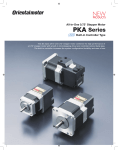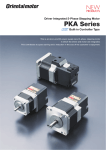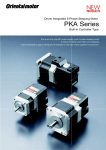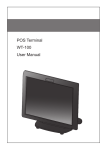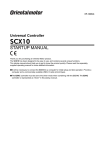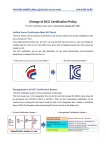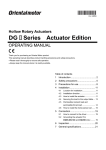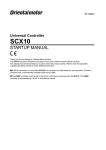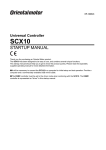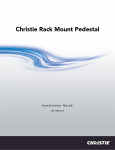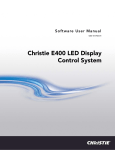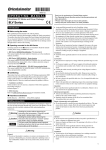Download OPERATING MANUAL PKA Series
Transcript
HM-60074-2 OPERATING MANUAL All-in-One 5-Phase Stepping Motor PKA Series KCC-REMOMC-061 Thank you for purchasing an Oriental Motor product. This Manual describes product handling procedures and safety precautions. • Please read it thoroughly to ensure safe operation. • Always keep the manual where it is readily available. Front side Introduction Before use Only qualified personnel should work with the product. Use the product correctly after thoroughly reading the section "Safety precautions." The product described in this manual has been designed and manufactured for use in general industrial equipment. Do not use for any other purpose. For the motor power supply, use a DC power supply with reinforced insulation on its primary and secondary sides. Oriental Motor Co., Ltd. is not responsible for any damage caused through failure to observe this warning. Operating Manuals for the PKA Series Operating manuals for the PKA Series are listed below. After reading the above manuals, keep them in a convenient place so that you can reference them at any time. Pilot Output shaft Name PWR LED (Green) ALM LED (Red) • PKA Series USER MANUAL (CD-ROM) This manual explains the function, installation and connection of the motor as well as operating method. DAT LED (Green) • PKA Series OPERATING MANUAL (this document) This manual explains safety precautions, connector pin assignments and others. ERR LED (Red) Hazardous substances RoHS (Directive 2002/95/EC 27Jan.2003) compliant 한국전파법 이 기기는 업무용 (A급) 전자파적합기기로서 판매자 또는 사용자는 이 점을 주의하시기 바라며, 가정외의 지역에서 사용하는 것을 목적으로 합니다. Function setting switches (SW1) Checking the product Verify that the items listed below are included. Report any missing or damaged items to the branch or sales office from which you purchased the product. • • • • • Motor................................................................1 unit CN1 leadwire/connector assembly ..................1 pc. [0.6 m (2 ft.), 12-pins] Connector cap ..................................................2 pcs. OPERATING MANUAL (this document)......1 copy USER MANUAL (CD-ROM) .........................1 pc. Names and functions of parts Transmission rate setting switch (SW3) Mounting holes (4 locations) Power supply and I/O signal connector (CN1) RS-485 communication connectors (CN2/CN3) Transmission rate setting switch (SW3) Address number setting switch (SW2) LED Function setting switches (SW1) Address number setting switch (SW2) Power supply and I/O signal connector (CN1) RS-485 communication connectors (CN2, CN3) Data edit connector (CN4) Mounting holes (4 locations) Description This LED is lit while the power is input. This LED will blink when an alarm generates. It is possible to check the generated alarm by counting the number of times the LED blinks. This LED will blink or illuminate steadily when the driver is communicating with the master station properly via RS-485 communication. This LED will illuminate when a RS-485 communication error occurs with the master station. Use this switch when controlling the system via RS-485 communication. • No.1, No.2: Set the termination resistor (120 Ω) of RS-485 communication. (Factory setting: OFF) • No.3: Using this switch and the address number setting switch (SW2), set the address number of RS-485 communication. (Factory setting: OFF) • No.4: Set the connection device of RS-485 communication. (Factory setting: OFF) • No.5, No.6: Not used. (Keep this switch in the OFF position.) Use this switch when controlling the system via RS-485 communication. Use this switch and SW1-No.3 of the function setting switch, to set the address number of RS-485 communication. (Factory setting: 0) Use this switch when controlling the system via RS-485 communication. Set the transmission rate of RS-485 communication (Factory setting: 7). Connect the main power supply (+24 VDC) and I/O signals. Connect the RS-485 communication cable. Connect a PC in which the MEXE02 has been installed, or the OPX-2A (both are accessories). Secure the motor with screws using these mounting holes. Data edit connector (CN4) 1 Installation Connection Note Location for installation The motor has been designed and manufactured to be installed within another device. Install it in a well-ventilated location that provides easy access for inspection. The location must also satisfy the following conditions: • Inside an enclosure that is installed indoors (provide vent holes) • Operating ambient temperature 0 to +50 °C (+32 to +122 °F) [non-freezing] • Operating ambient humidity 85% or less [non-condensing] • Area that is free of explosive atmosphere or toxic gas (such as sulfuric gas) • • • • • • • • or liquid Area not exposed to direct sun Area free of excessive amount of dust, iron particles or the like Area not subject to splashing water (rain, water droplets), oil (oil droplets) or other liquids Area free of excessive salt Area not subject to continuous vibration or excessive shocks Area free of excessive electromagnetic noise (from welders, power machinery, etc.) Area free of radioactive materials, magnetic fields or vacuum 1000 m (3300 ft.) or lower above sea level • Ensure that the connector plugged in securely. Insecure connection may cause malfunction or damage to the motor. • When unplugging the connector, do so while pressing the latches on the connector. • When plugging/unplugging the connector, turn off the power and wait for the PWR LED to turn off before doing so. Connection of power supply and I/O signals, grounding motor Connect the power supply and I/O signals to the motor using the supplied CN1 leadwire/connector assembly (12-pins). DC power supply 24 VDC±10% Installation method +24 V GND The motor can be installed in any direction. Install the motor onto an appropriate flat metal plate having excellent vibration resistance and heat conductivity. When installing the motor, secure it with four bolts (not supplied) through the four mounting holes provided. Do not leave a gap between the motor and metal plate. Insert the pilot located on the motor's installation surface into the mounting plate's. • Installation method A • Installation method B Pilot Metal plate Pilot Mounting hole Nominal size PKA544KD PKA566KD M3 M4 Tightening torque [N·m (oz-in)] 1 (142) 2 (280) Effective depth of bolt [mm (in.)] 4.5 (0.177) − FG • Connecting the power supply Use a power supply that can supply the current capacity show in the table below. Model Input power supply voltage PKA544KD PKA566KD 24 VDC±10% Power supply current capacity 1.4 A or more 2.5 A or more • Mounting hole Metal plate Model Programmable controller Installation method A B Grounding method Ground the Frame Ground terminal (FG) of pin No.1 as necessary. Ground using a wire of AWG24 to 16 (0.2 to 1.25 mm2), and do not share the Protective Earth Terminal with a welder or any other power equipment. Pin assignments • CN1 connector pin assignments Lead wire color Yellow Black/White Orange Red/White Green Blue Purple Gray White Black Brown Red Pin No. 1 2 3 4 5 6 7 8 9 10 11 12 Signal name FG GND IN-COM +24 VDC IN0 IN1 IN2 IN3 OUT0+ OUT0− OUT1+ OUT1− 12 2 11 1 Description∗ Frame Ground Power supply GND Input common +24 VDC power supply input Control input 0 (+LS) Control input 1 (−LS) Control input 2 (HOMES) Control input 3 (STOP) Control output 0 (ALM) Control output 1 (READY) ∗ ( ): Initial value 2 • 4 3 CN2/CN3 connector pin assignments 2 1 Pin No. 1 2 3 4 Signal name TR+ TR− GND FG Description RS-485 communication signal (+) RS-485 communication signal (−) GND Frame Ground • Transmission rate Set the transmission rate using transmission rate setting switch (SW3). The transmission rate to be set should be the same as the transmission rate of the master device. Factory setting 7 (625,000 bps) Note SW3 0 1 2 3 Transmission rate (bps) 9600 19200 38400 57600 Do not set SW3 to positions 5 to F. The factory setting "7" is the transmission rate for when connecting to the network converter. • Termination resistor Use a termination resistor for the motor located farthest away (positioned at the end) from the programmable controller (master device). Turn SW1-No.1 and No.2 of the function setting switch ON to set the termination resistor for RS-485 communication (120 Ω). Factory setting No.1 and No.2: Both OFF (termination resistor disabled) Setting the switches SW1- No.1, No.2 OFF ON Termination resistor (120 Ω) Disabled Enabled Safety precautions Function setting switches (SW1) No.1, No.2: Set the termination resistor No.3: Set the address number No.4: Set the connection device No.5, No.6: Not used Note Transmission rate setting switch (SW3) Address number setting switch (SW2) Be sure to turn off the motor power before setting the switches. If the switches are set while the power is still on, the new switch settings will not become effective until the motor power is cycled. • Setting the connection device Set the connection device of RS-485 communication using the function setting switch SW1-No.4. Set to ON when controlling via Modbus protocol. Factory setting OFF (Network converter) SW1-No.4 ON OFF Connection device General purpose master device (Modbus protocol) Network converter • Address number (slave address) Set the address number (slave address) using the address number setting switch (SW2) and SW1-No.3 of the function setting switch. Make sure each address number (slave address) you set for each driver is unique. Address number (slave address) 0 is reserved for broadcasting, so do not use this address. Factory setting SW1-No.3: OFF, SW2: 0 (Address number 0) SW1No.3 SW2 OFF 0 1 2 3 4 5 6 7 8 9 A B C D E F Address number (slave address) Not used 1 2 3 4 5 6 7 8 9 10 11 12 13 14 15 SW1No.3 SW2 ON 0 1 2 3 4 5 6 7 8 9 A B C D E F Address number (slave address) 16 17 18 19 20 21 22 23 24 25 26 27 28 29 30 31 The precautions described below are intended to prevent danger or injury to the user and other personnel through safe, correct use of the product. Use the product only after carefully reading and fully understanding these instructions. Warning Handling the product without observing the instructions that accompany a "Warning" symbol may result in serious injury or death. General • Do not use the product in explosive or corrosive environments, in the presence of flammable gases, locations subjected to splashing water, or near combustibles. Failure to do so may result in fire or injury. • Assign qualified personnel the task of installing, wiring, operating/controlling, inspecting and troubleshooting the product. Failure to do so may result in fire, injury or damage to equipment. • When the power is shut off or the motor does not maintain excitation, the motor will lose the holding torque. Take measures to keep the moving parts in position for vertical operations such as elevator applications. Failure to do so will cause the moving parts to fall and it may result in injury or damage to equipment. • Depending on the type of the alarm (protective function), the motor may stop and lose its holding torque when the alarm generates. This may cause injury or damage to equipment. • When the motor generates an alarm (any of the motor's protective functions is triggered), first remove the cause and then clear the protection function. Continuing the operation without removing the cause of the problem may cause malfunction of the motor, leading to injury or damage to equipment. Connection • Keep the motor's input-power voltage within the specified range to avoid fire. • For the motor power supply, use a DC power supply with reinforced insulation on its primary and secondary sides. Failure to do so may cause electric shock. • Connect the cables securely according to the wiring diagram in order to prevent fire. • Do not forcibly bend, pull or pinch the cable or lead wire. Doing so may cause fire. Applying stress to the connection area of the connectors may cause damage to the product. Operation • Turn off the power in the event of a power failure. Or the motor may suddenly start when the power is restored and may cause injury or damage to equipment. • Do not turn the motor excitation OFF while operating. The motor will stop its operation and lose the holding torque. This may cause injury or damage to equipment. • Configure an interlock circuit in sequence program so that the system including the motor operates on the safe side when a RS-485 communication error generates. 3 Repair, disassembly and modification • Do not disassemble or modify the motor. Refer all such internal inspections and repairs to the branch or sales office from which you purchased the product. Caution Handling the product without observing the instructions that accompany a “Caution” symbol may result in injury or property damage. General • Do not use the motor beyond its specifications. Doing so may result in injury or damage to equipment. • Keep your fingers and objects out of the openings in the motor. Failure to do so may result in fire or injury. • Do not touch the motor during operation or immediately after stopping. The surface is hot and may cause a skin burn(s). Transportation • Do not carry the motor by holding the motor output shaft or leadwire/connector assembly. Doing so may cause injury. Installation • Install the motor in the enclosure in order to prevent injury. • Keep the area around the motor free of combustible materials in order to prevent fire or a skin burn(s). • Provide a cover over the rotating parts (output shaft) of the motor. Failure to do so may result in injury. Connection • The connectors CN1, CN2, CN3 and CN4 of the motor are not electrically insulated. When grounding the positive terminal of the power supply, do not connect any equipment (PC, etc.) whose negative terminal is grounded. Doing so may cause the motor and these equipment to short, damaging both. • When connecting, check the indication of the motor and be sure to observe the polarity of the power supply. Reverse-polarity connection may cause damage to the motor. The power-supply circuit and the RS-485 communication circuit are not electrically insulated. Therefore, when controlling multiple motors via RS-485 communication, the reverse polarity of the power supply will cause a short circuit and may result in damage to the motors. Operation • Provide an emergency stop device or emergency stop circuit external to • • • • • the equipment so that the entire equipment will operate safely in the event of a system failure or malfunction. Failure to do so may result in injury. Before supplying power to the motor, turn all input signals to the motor OFF. Otherwise, the motor may start suddenly at power on and cause injury or damage to equipment. Set a suitable operation speed and acceleration/deceleration rate. Improper setting may cause loss of the motor synchronism and moving the load to an unexpected direction, which may result in injury or damage to equipment. Do not touch the rotating part (output shaft) during operation. Doing so may cause injury. When rotating the output shaft manually while the motor stops, cut off the motor current by turning off the power supply or motor excitation. Failure to do so may cause injury. The motor surface temperature may exceed 70 °C (158 °F) even under normal operating conditions. If the operator is allowed to approach the running motor, attach a warning label as shown below in a conspicuous position. Failure to Warning do so may result in skin burn(s). label • Immediately when trouble has occurred, stop running and turn off the motor power. Failure to do so may result in fire or injury. • Static electricity may cause the motor to malfunction or suffer damage. While the motor is receiving power, do not touch the motor. Always use an insulated screwdriver to adjust the motor's switches. Disposal • To dispose of the motor, disassemble it into parts and components as much as possible and dispose of individual parts/components as industrial waste. 4 • Unauthorized reproduction or copying of all or part of this manual is prohibited. • Oriental Motor shall not be liable whatsoever for any problems relating to industrial property rights arising from use of any information, circuit, equipment or device provided or referenced in this manual. • Characteristics, specifications and dimensions are subject to change without notice. • While we make every effort to offer accurate information in the manual, we welcome your input. Should you find unclear descriptions, errors or omissions, please contact the nearest office. • is a registered trademark or trademark of Oriental Motor Co., Ltd., in Japan and other countries. © Copyright ORIENTAL MOTOR CO., LTD. 2012 • Please contact your nearest Oriental Motor office for further information. Technical Support Tel:(800)468-3982 8:30 A.M. to 5:00 P.M., P.S.T. (M-F) 7:30 A.M. to 5:00 P.M., C.S.T. (M-F) E-mail: [email protected] www.orientalmotor.com Headquarters and Düsseldorf Office Tel:0211-52067-00 Fax:0211-52067-099 Munich Office Tel:089-3181225-00 Fax:089-3181225-25 Hamburg Office Tel:040-76910443 Fax:040-76910445 Tel:01256-347090 Fax:01256-347099 Tel:01 47 86 97 50 Fax:01 47 82 45 16 Tel:02-93906346 Fax:02-93906348 Tel:400-820-6516 Fax:021-6278-0269 Tel:(02)8228-0707 Fax:(02)8228-0708 Tel:+65-6745-7344 Fax:+65-6745-9405 Tel:(03)22875778 Fax:(03)22875528 Tel:+66-2-251-1871 Fax:+66-2-251-1872 KOREA Tel:080-777-2042 Fax:02-2026-5495 Headquarters Tokyo, Japan Tel:03-6744-0361 Fax:03-5826-2576







